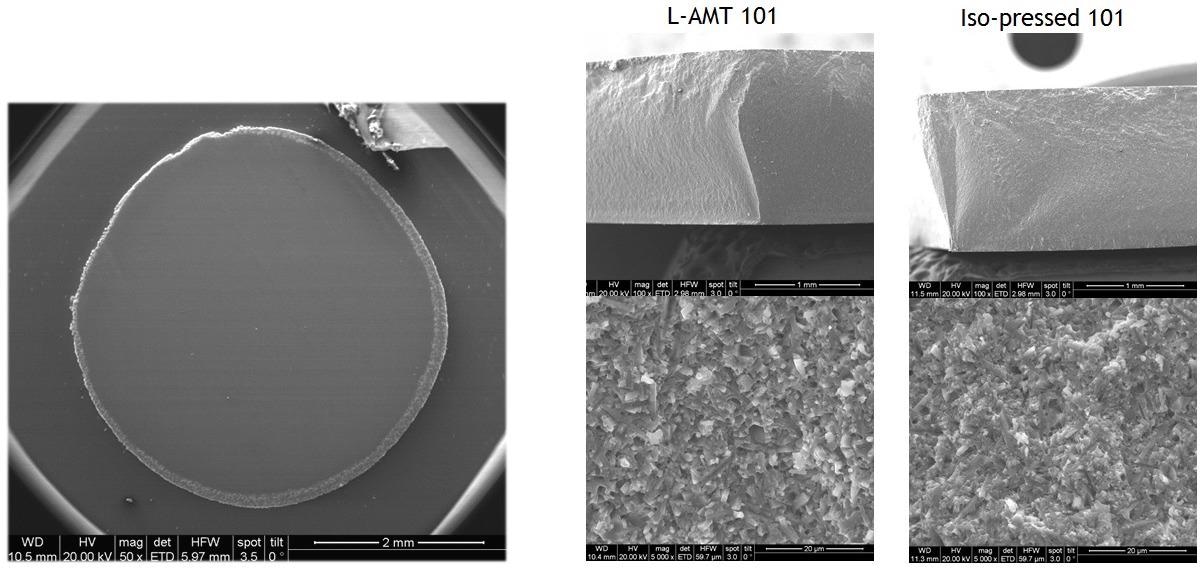Silicon nitrides (Si3N4) are a range of advanced engineering ceramics characterised by high strength, toughness and hardness and excellent chemical and thermal stability. Silicon nitride was discovered in the mid-nineteenth century but did not lend itself to ease of fabrication, due to its covalently bonded nature.

Image Credits: shutterstock.com/Fablok
Types of Silicon Nitride Ceramics
This initially led to the development of two types of silicon nitride, reaction–bonded silicon nitride (RBSN) and hot pressed silicon nitride (HPSN). Subsequently, since the 1970s two further types have been developed: sintered silicon nitride (SSN), which include the sialons, and sintered reaction–bonded silicon nitride (SRBSN).
Silicon Nitride Engineering Materials
The current interest in silicon nitride based engineering materials essentially developed from the research in the 1980s in to ceramic parts for gas turbine and piston engines. It was envisaged that an engine, predominately made from silicon nitride based parts, such as sialon, would be light weight and be able to operate at higher temperatures than traditional engines resulting in higher efficiencies. Ultimately however, this goal was not realised as a result of a number of factors including cost, the difficultly in reliably fabricating the parts and the inherent brittle nature of ceramics.
Applications of Silicon Nitride
However, this work led to the development of a number of other industrial applications for silicon nitride based materials, such as in metal forming, industrial wear and molten metal handling. The different types of silicon nitride, RBSN, HPSN, SRBSN and SSN, result from their method of fabrication, which governs their resulting properties and applications.
Reaction-Bonded Silicon Nitride (RBSN)
Reaction–Bonded Silicon Nitride (RBSN) is made by carefully nitriding a silicon (Si) ‘dough’ or compact at about 1450°C. During the reaction the Si3N4 grows in the porosity in the compact. This results in little dimensional change accompanied by an increase in density. This feature is the biggest benefit of RBSN, as it often allows parts to be made to near net shape without the need for subsequent expensive grinding operations.
A consequence of this reaction is that the final product contains porosity and as such its mechanical properties are inferior to those of the other types of silicon nitride, as shown in the table below. However, the material is relatively cheap to produce and has found application particularly as kiln furniture.
Hot Pressed Silicon Nitride (HPSN)
Hot Pressed Silicon Nitride (HPSN) was developed in the 1960s and 1970s with the aim of allowing engineers to utilise some of the outstanding properties of silicon çarbide, which couldn't be achieved with RBSN. HPSN is made by adding a flux (usually magnesia) to a fine Si3N4 powder and then pressing the powder in a graphite die typically at 1800°C and 40MPa of pressure. The resultant body is fully dense with excellent mechanical properties (see below).
These HPSN have found application as cutting tools for example. Applications tend to be for relatively simple shapes as the hot pressed ‘billet’ must be diamond ground to obtain the required profile. As a result HPSN parts tend to be expensive and have now largely been superseded by SSN.
Sintered Reaction - Bonded Silicon Nitride (SRBSN)
RBSN is a development on RBSN aimed at reducing the final porosity of the product and therefore improving its mechanical properties (see below). This is acheived by adding sintering additives to the starting powder mix which allows the material to be sintered after the reaction–bonding stage. Although there is now a significant shrinkage, it is smaller than for SSN and allows greater control.
As with RBSN, the starting raw materials for SRBSN, principally silicon metal, are relatively cheap compared to high quality silicon nitride powders and so SRBSN is therefore cheaper to manufacture than both HPSN and SSN. Applications of SRBSN include cutting tools and wear components.
More recent developments of these materials has shown improvements in toughness and impact resistance as a result of the growth of crack deflecting √ whiskers.
Sintered Silicon Nitride
Sintered Silicon Nitride (SSN) covers silicon nitride materials which are densified by pressureless sintering in a nitrogen atmosphere at around 1750°C. In order to aid densification, various combinations of sintering additives such as yttrium oxide, magnesium oxide and aluminium oxide are used. Where there is an addition of an aluminium containing additive the sintered material can be classed as a sialon. Sialons are ceramic alloys based on the elements silicon (Si), aluminium (Al), oxygen (O) and nitrogen (N) and the term is often used interchangeably with SSN. The physical properties of SSN and Syalon 101, a sialon manufactured by International Syalons, are compared with the other common types of silicon nitride in the table below.
SSN and sialon generally offer the best mechanical properties available for a silicon nitride and are the most widely used in industrial applications such as molten metal handling, industrial wear, metal forming, the oil and gas industries and the chemical and process industries.
Comparison of Physical Properties of Different Silicon Nitride
The following table is a comparison of physical property data for RBSN, HPSN, SRBSN, SSN and Syalon 101.
Table 1. Comparison of Physical property data for RBSN, HPSN, SRBSN, SSN and Syalon 101.
|
|
|
|
|
|
|
|
3 point RT Modulus of Rupture (MPa)
|
200
|
700
|
700
|
850
|
945
|
|
RT Young's Modulus of Elasticity (GPa)
|
175
|
300
|
300
|
300
|
288
|
|
RT Hardness Vickers Hv0.3 (Kg/mm2)
|
800
|
1650
|
1450
|
1450
|
1500
|
|
Fracture Toughness K¹C (MPam½)
|
2.5
|
4.5
|
6.0
|
7.5
|
7.7
|
|
Density (g/cc)
|
2.3
|
3.2
|
3.3
|
3.24
|
3.23
|
|
Porosity (%)
|
30
|
0
|
5
|
0
|
0
|
|
Thermal Expansion Coeff. (0-1200°C) (10-6/K-1)
|
3.2
|
3.2
|
3.1
|
3.1
|
3.04
|
|
RT Thermal Conductivity (W/m/K)
|
10
|
26
|
25
|
22
|
21.3
|
|
Thermal Shock Resistance (ΔT°C)
|
400
|
700
|
700
|
800
|
900
|
|
RT Electrical Resistivity (ohm m)
|
1010
|
1010
|
1010
|
1010
|
1010
|
Summary on Silicon Nitride Ceramic
Silicon nitride (Si3N4) is a very important engineering ceramic which is available in several forms, each with their own unique properties. These include high strength, toughness and hardness, excellent wear resistance, corrosion resistance to many acids and alkalis and outstanding thermal shock resistance. These properties are enabling silicon nitride, and in particular SSN and sialon, to find use in many industrial applications. As the materials are becoming more widely accepted and used, new applications are being discovered all the time.

This information has been sourced, reviewed and adapted from materials provided by International Syalons.
For more information on this source, please visit International Syalons.